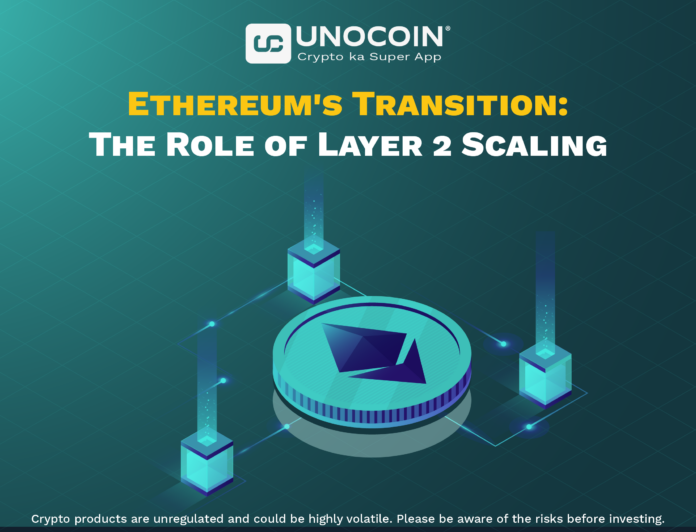Ethereum’s Transition: The Role of Layer 2 Scaling
Ethereum, the leading blockchain platform, has long been at the forefront of decentralized applications and smart contracts. However, as the network faced scalability issues, the need for an efficient scaling solution was evident. Enter Layer 2 Scaling, a key aspect of Ethereum’s transition that aims to improve scalability and address congestion issues.
Understanding Layer 2 Scaling:
Layer 2 solutions operate on top of the main Ethereum network and provide a way to process transactions more efficiently and at a lower cost. They effectively alleviate network congestion by moving a significant portion of transactions off the main blockchain, offering users and developers a scalable and cost-effective alternative.
One prominent example of layer 2 scaling is the rollup implementation that includes Optimistic Rollups and zk-Rollups. These solutions make it easy to pool multiple transactions into a single batch, reducing the load on the Ethereum network and significantly increasing throughput.
Additionally, Ethereum’s transition to a proof-of-stake (PoS) consensus mechanism with Ethereum 2.0 is a complementary effort to address scalability issues. PoS is expected to increase network efficiency and reduce energy consumption, contributing to a more sustainable and scalable Ethereum ecosystem.
Scalability Wars: Layer 2 Solutions Competing for Dominance
The push for scalability has given rise to what are often referred to as the “scalability wars” within the blockchain. Various second-layer solutions compete for dominance, each offering unique features and optimizations to attract users and developers looking for faster and more cost-effective transactions.
Optimistic summaries:
Optimistic Rollups work on the assumption of optimistic execution. They process off-chain transactions and then submit a summary of those transactions to the Ethereum mainnet. While this approach significantly reduces gas fees and increases transaction speed, there is a trade-off between efficiency and security. Users must trust that aggregated data accurately represents off-chain transactions.
zk-rollups:
Zero-knowledge (zk) Rollups use advanced cryptographic techniques to ensure the validity of off-chain transactions without revealing transaction details. This approach increases security by providing a trustless environment where users do not have to rely on the honesty of a centralized entity. zk-Rollups offers a compelling solution for those who prioritize security while still reaping the benefits of scalability.
Choosing the right Layer 2 solution:
The competition between Layer 2 solutions underscores the importance of carefully evaluating the trade-offs and choosing a solution that matches specific use cases and preferences. Developers and users must consider factors such as security, decentralization, and ease of integration when choosing a Layer 2 scaling solution.
Security and trust:
While Optimistic Rollups provide scalability with a security trade-off, zk-Rollups prioritize trust and security. The choice between these solutions often depends on the level of security required for a particular application or transaction.
Easy integration and development:
Developers need solutions that integrate seamlessly with existing applications. Ease of development and integration can influence the choice between Optimistic Rollups and zk-Rollups, as well as other layer 2 solutions on the market.
User experience and cost-effectiveness:
From the user’s perspective, cost-effective transactions and a smooth overall experience are paramount. Layer 2 solutions that strike the right balance between transaction speed, cost efficiency and security are likely to gain wider adoption.
Conclusion: Navigating Ethereum’s Scalability Landscape
Ethereum’s transition to a layer 2 scaling solution is a key moment in blockchain development. As the scalability wars unfold, the Ethereum community is faced with the task of choosing the most appropriate layer 2 solution. Whether it is the optimistic execution of Optimistic Rollups or the cryptographic security of zk-Rollups, the chosen path will shape the future of Ethereum scalability, making it a critical consideration for developers, users, and the wider blockchain ecosystem. The journey to a more scalable and efficient Ethereum is well underway, and the decisions made today will define the landscape of decentralized applications and transactions for years to come.
Please find the list of authentic Unocoin accounts for all your queries below:
- YouTube Channel: https://www.youtube.com/c/Unocoin/videos
- Newsletter: https://medium.com/subscribe/@Unocoin_growth
- Blogs: https://blog.unocoin.com
- Instagram: https://www.instagram.com/unocoin/
- Twitter: https://twitter.com/Unocoin
- Facebook: https://www.facebook.com/unocoin/
- LinkedIn: https://in.linkedin.com/company/unocoin
- Telegram Group: https://t.me/Unocoin_Group
- Telegram Channel: https://t.me/+fasQhTKBsfA5N2Zl
- Telegram: https://t.me/UnocoinSupport_Bot
- E-mail id: [email protected]
- Contact details: 7788978910 (09:30 AM IST – 06:30 PM, Mon – Sat)
- App store link: https://apps.apple.com/us/app/unocoin/id1030422972?ls=1
- Playstore link: https://play.google.com/store/apps/details?id=com.unocoin.unocoinwallet
Disclaimer: Crypto products are unregulated as of this date in India. They could be highly volatile. At Unocoin, we understand that there is a need to protect consumer interests as this form of trading and investment has risks that consumers may not be aware of. To ensure that consumers who deal in crypto products are not misled, they are advised to DYOR (Do Your Own Research).




![Fundamental Analysis in Crypto [Updated Guide] A Comprehensive Guide to Asset Valuation.png](https://blog.unocoin.com/wp-content/uploads/2024/11/A-Comprehensive-Guide-to-Asset-Valuation-218x150.png)